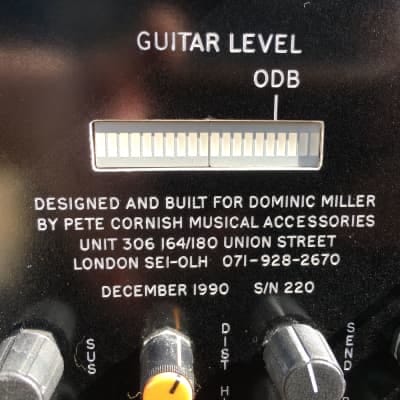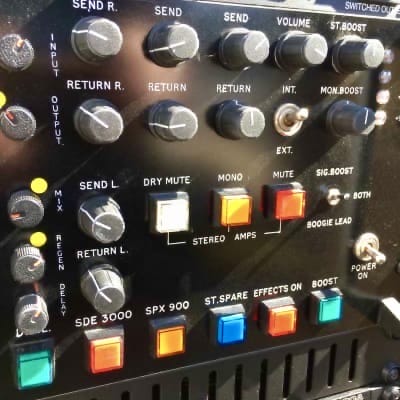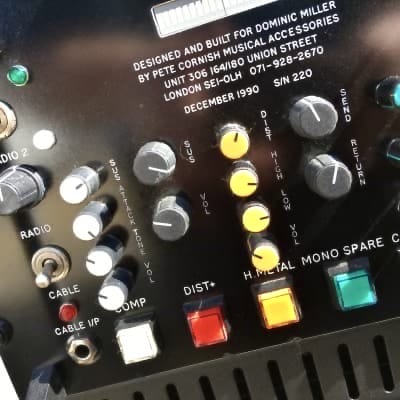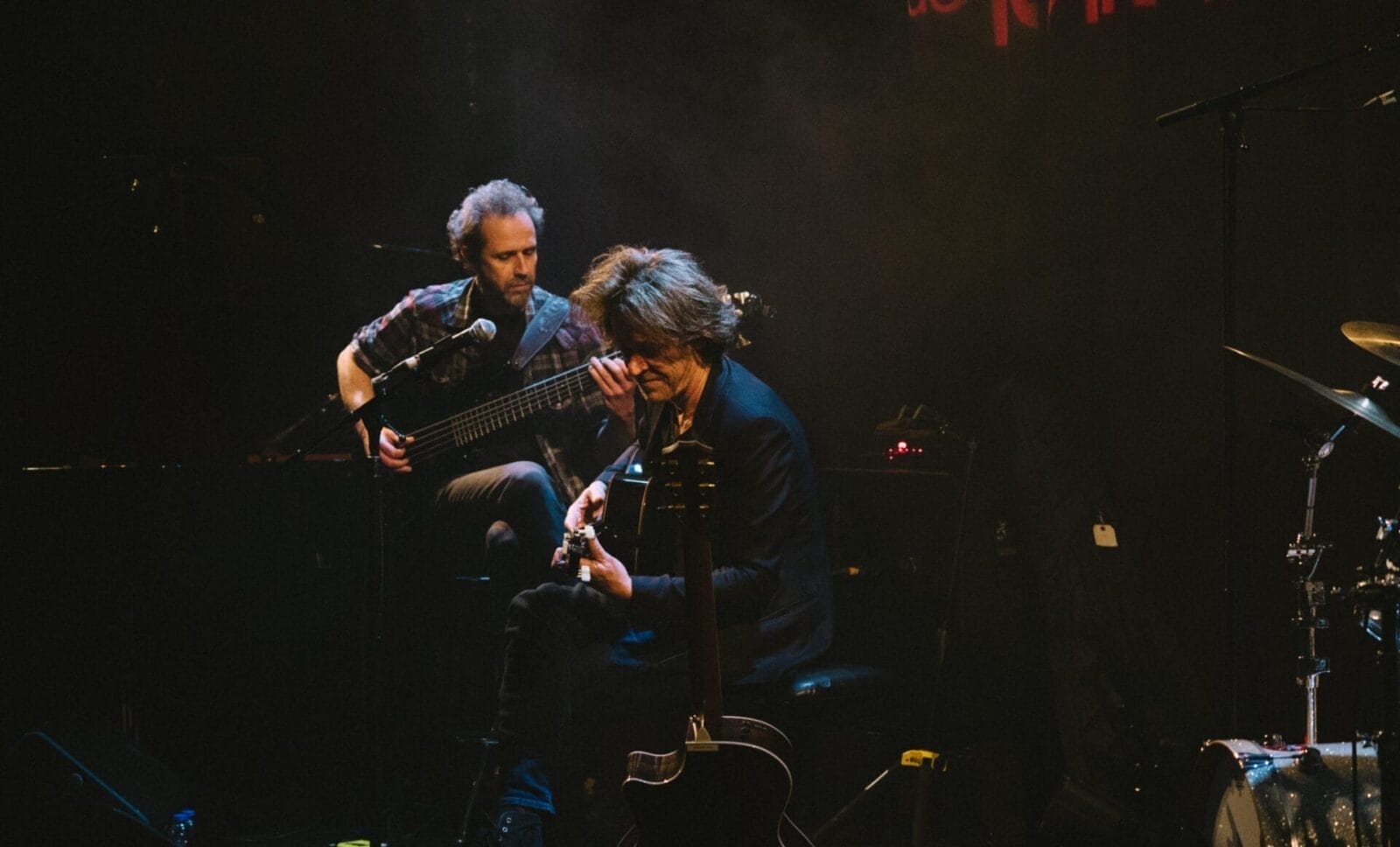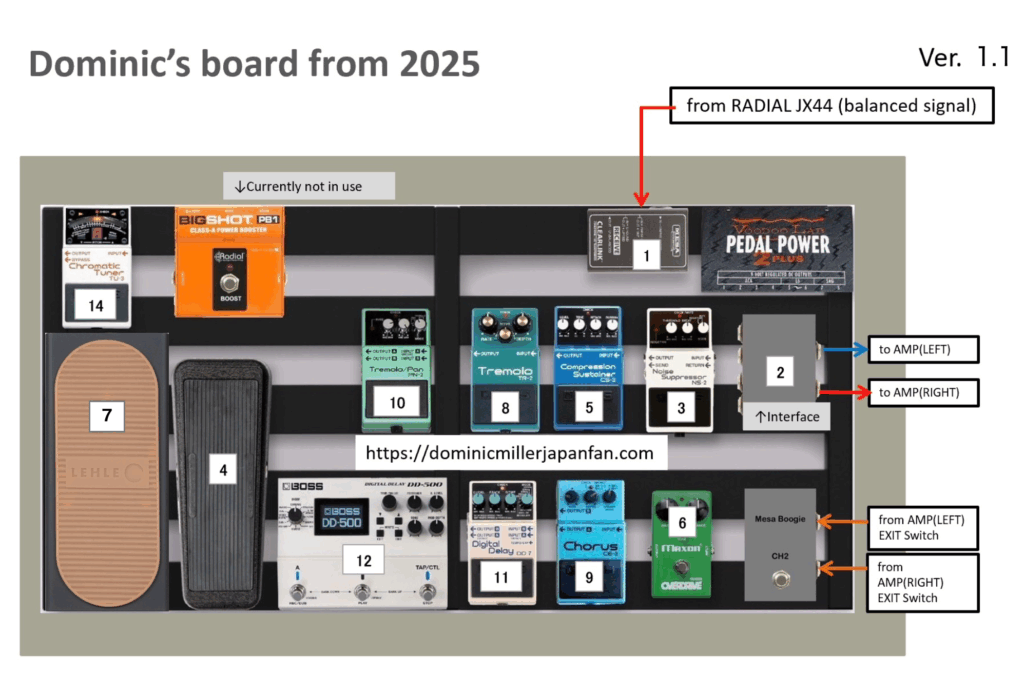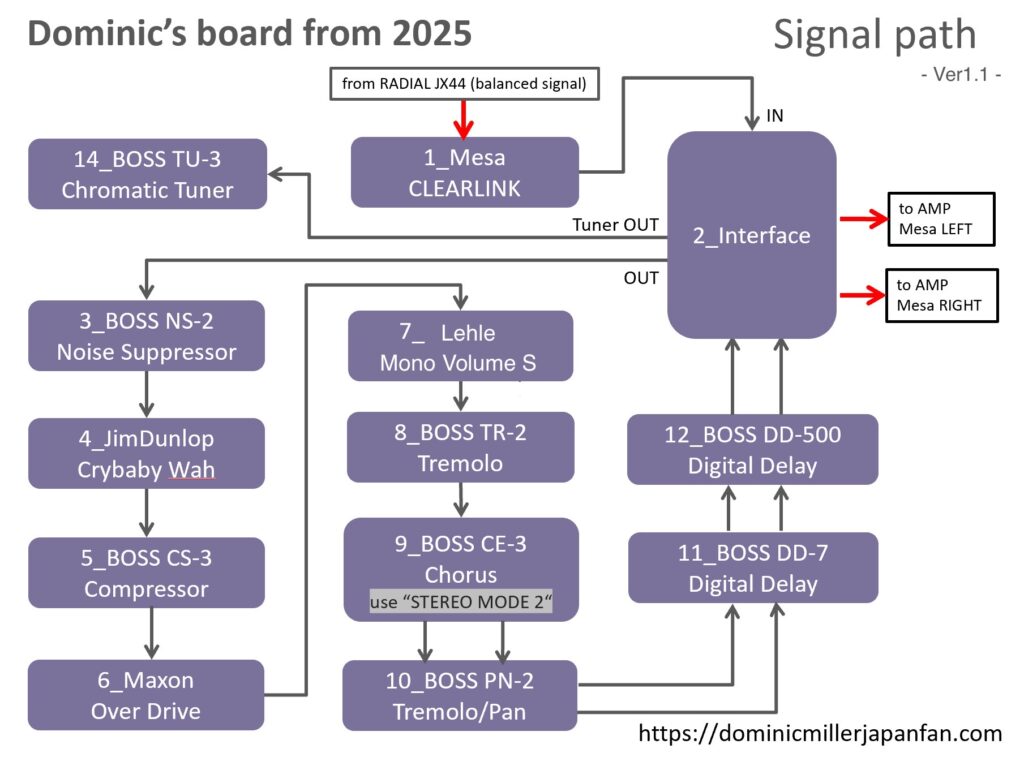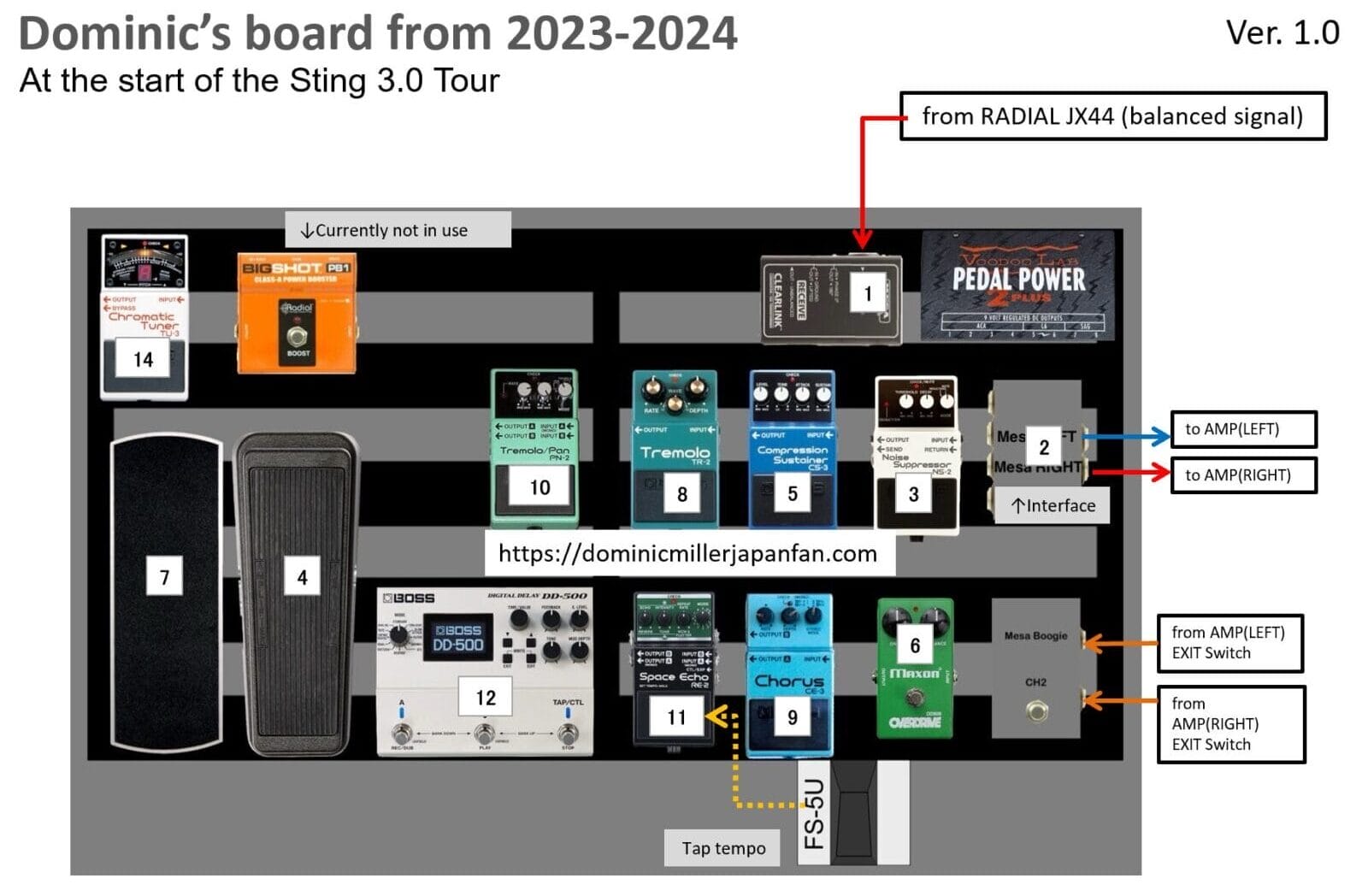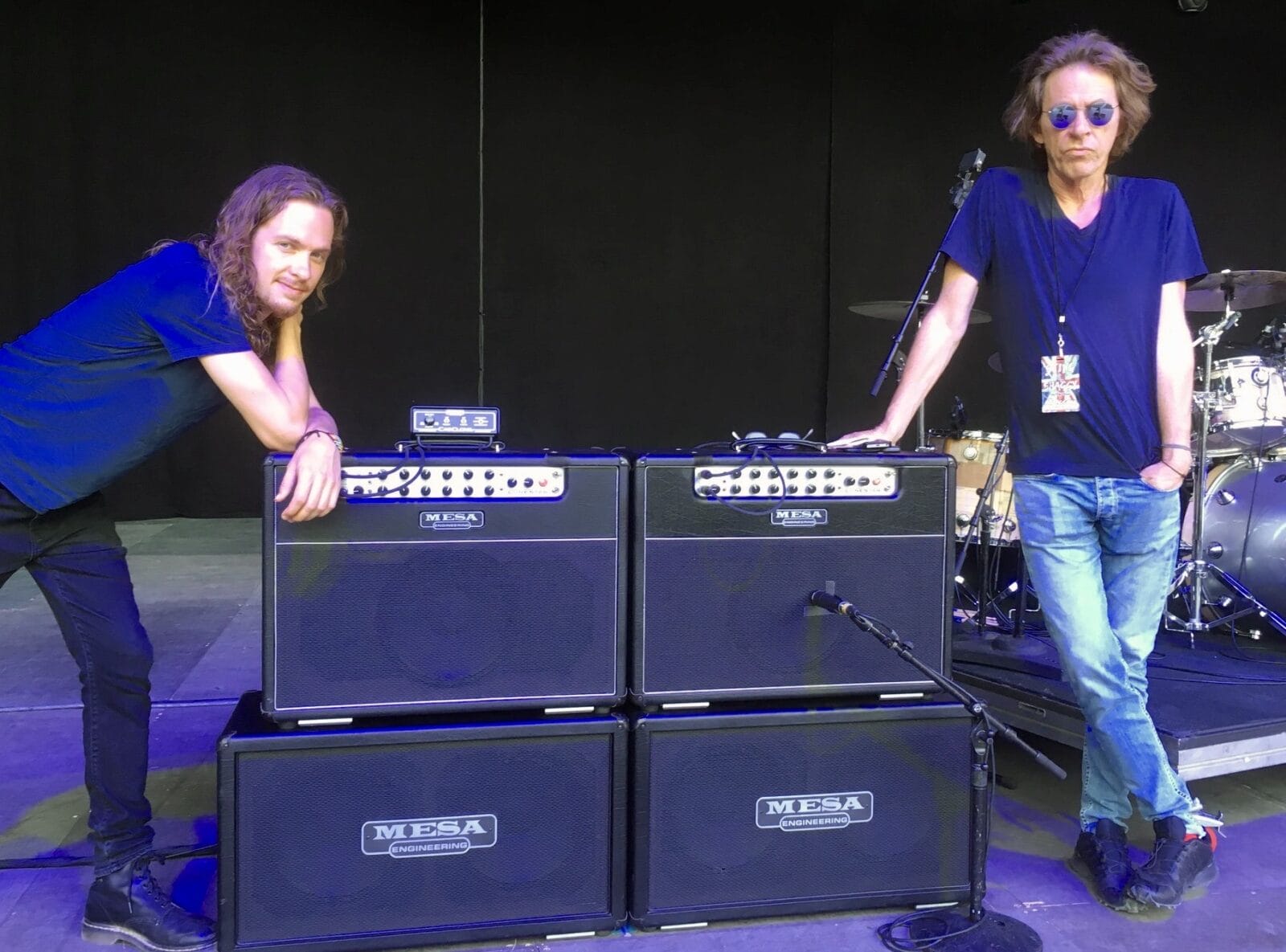ドミニクのペダルボード、PAシステムとアンプ類
Dom’s Pedalboard, PA System and Amps
ドミニクの長年のギター・テックであるリッチー・マゼッタが、ドミニクの最新のペダルボード、アンプの設定、そしてスティングのツアー用のPAシステムについて教えてくれたので、詳しく説明しよう。特にペダルボードの写真は、リッチーが配線をし終わったばかりの最新のものです。(2025.2.14)更新:2025年7月26日、6月6日(ペダルボードに変更あり)
Dominic’s long-time guitar tech, Richie Mazzetta, told me about Dominic’s latest pedalboard, amp setting and PA system for Sting’s tour, In particular, the photo of the pedalboard is the latest one, as Richie has just finished wiring it. (14. 2. 2025) Update Information: July 26, June 6 2025(Pedalboard changed)
まずは、ドミニクのステージのPAシステム構成について。下図は、それまでに私が知っていたドミニクの機材情報をもとに、リッチーに確認して作成したものです。ドミニクは曲の中でエレキギターとアコースティックギターの両方を使用するため、エレキ用とアコースティック用の2つの系統に分かれます。
全体のPAシステムとエレキギター系統
まずエレキギターの系統です。途中のBのワイヤレスの受信機と、Cのスイッチャーは2022年の夏頃の情報なので、今はもう新しい機材に変わっているかもしれない。リッチーも「Radial SwitcherとShureワイヤレスユニットもありますが、ワイヤレス技術は数年ごとに向上するので、それに応じてアップグレードしています。」と言ってたので、変わっている可能性は高い。しかし、基本的な仕組みは同じだ。



A: 61年ストラトなどエレキギターの音はまずワイヤレスでPAラックの中にあるB:Shure ULXD4Dデュアルチャンネルデジタルワイヤレス受信機に送られます。このワイヤレスレシーバーの後、すべての信号は有線ケーブルで送信されます。
B:Shure ULXD4Dデュアルチャンネルデジタルワイヤレス受信機→スイッチャーのC:Radial JX44 Guitar Signal Manager→D:ペダルボードの中のMesa/Boogie CLEARLINK Receiverにラインで送られます。
そこからいくつかのエフェクターを経由してE:Boss CE-3Chorusに入ります。Boss CE-3Chorusではステレオモード2を使用することで、それ以降の音はステレオサウンドになり、左右のF,G:のMesa Boogie Lone Star 1×12 Combo amp+Rectifier 2×12 Cabinetに送られます。
そして、客席から見て右のF: Mesa Boogie Lone Star 1×12 Combo amp+Rectifier 2×12 Cabinetの音はI:マイクで拾われて、Jのミキサー卓へ送られます。また、左のF: Mesa Boogie Lone Star 1×12 Combo amp+Rectifier 2×12 Cabinetの音はH:Mesa Boogie Lonestar/Cab Cloneを通してからJのミキサー卓へ送られます。Jのミキサー卓でI:マイクの音とH:Cab Cloneからの音をMixした後、ステージ左右のK:PAに送られて客席に届きます。
アコースティックギター系統
次にアコースティック・ギターの系統を説明します。

1:ギルド・パロマやペレグリンなどの音も、まずワイヤレスでPAラックの中にあるB:Shure ULXD4Dデュアルチャンネルデジタルワイヤレス受信機に送られます。そこからは有線配線になります。
2:Shure ULXD4Dデュアルチャンネルデジタルワイヤレス受信機→スイッチャーのC:Radial JX44 Guitar Signal ManagerのDIにラインインされます。そしてそれはそのままミキサー卓へ送られて、リバーブなど最小限の処理をされてそのままステージ左右のK:PAに送られて客席に届きます。
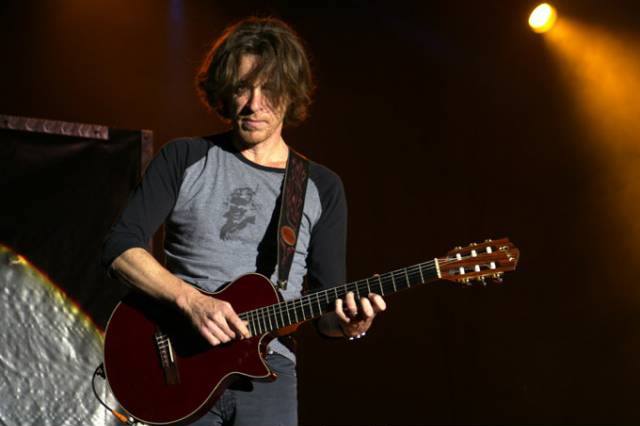
2025.07.26時点ペダルボード
2025年7月26日更新:またリッチーから新しいドミニクのペダルボードの写真を貰いました。下の6月の配線図3番にあったBOSS NS-2Noise Suppressorが無くなり、11番の位置のBOSS DD-7 Digital DelayがBOSS RE-2 Space Echo RE-2に戻りました。なのでTap Tempoのフットスイッチも戻りました。CE-3 Chorusの位置が左上に変更になりましたが、リッチーに確認したところ、配線の順番に変更は無いという事です。というのも、CE-3 Chorus はドムが絶対にオフにすることはなく、ほぼ 99% の時間オンになっているので、PN-2 Tremolo/Panをペダルボードの下部に移動して、ドムがよりアクセスしやすいようにした、との事です。
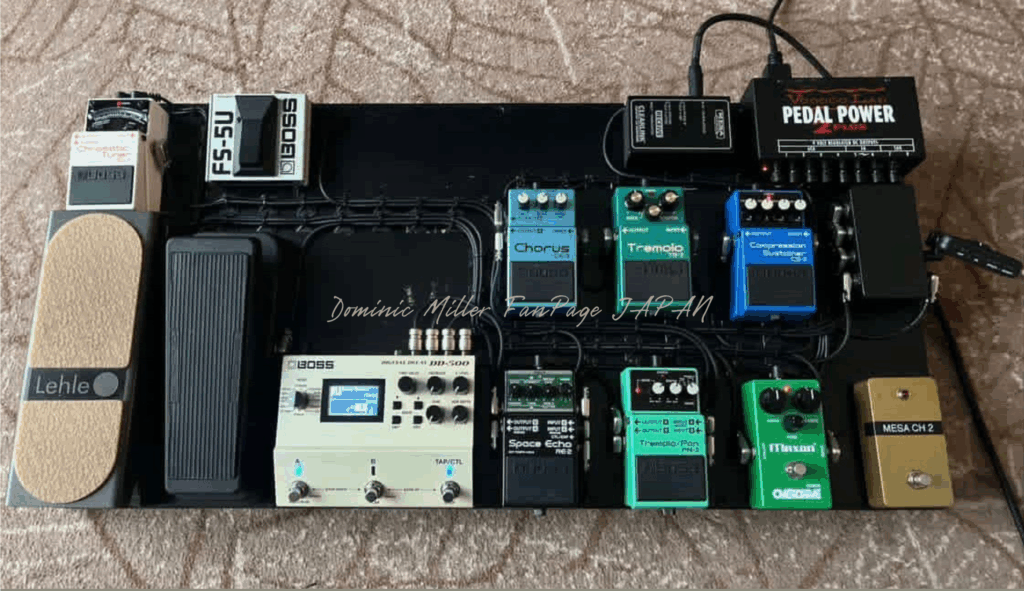
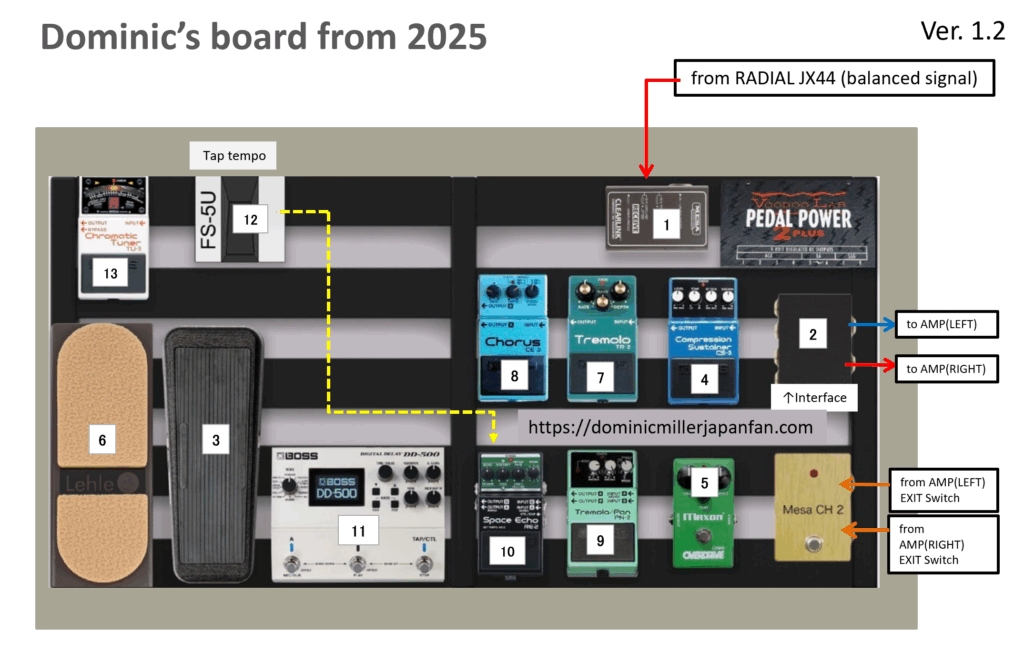
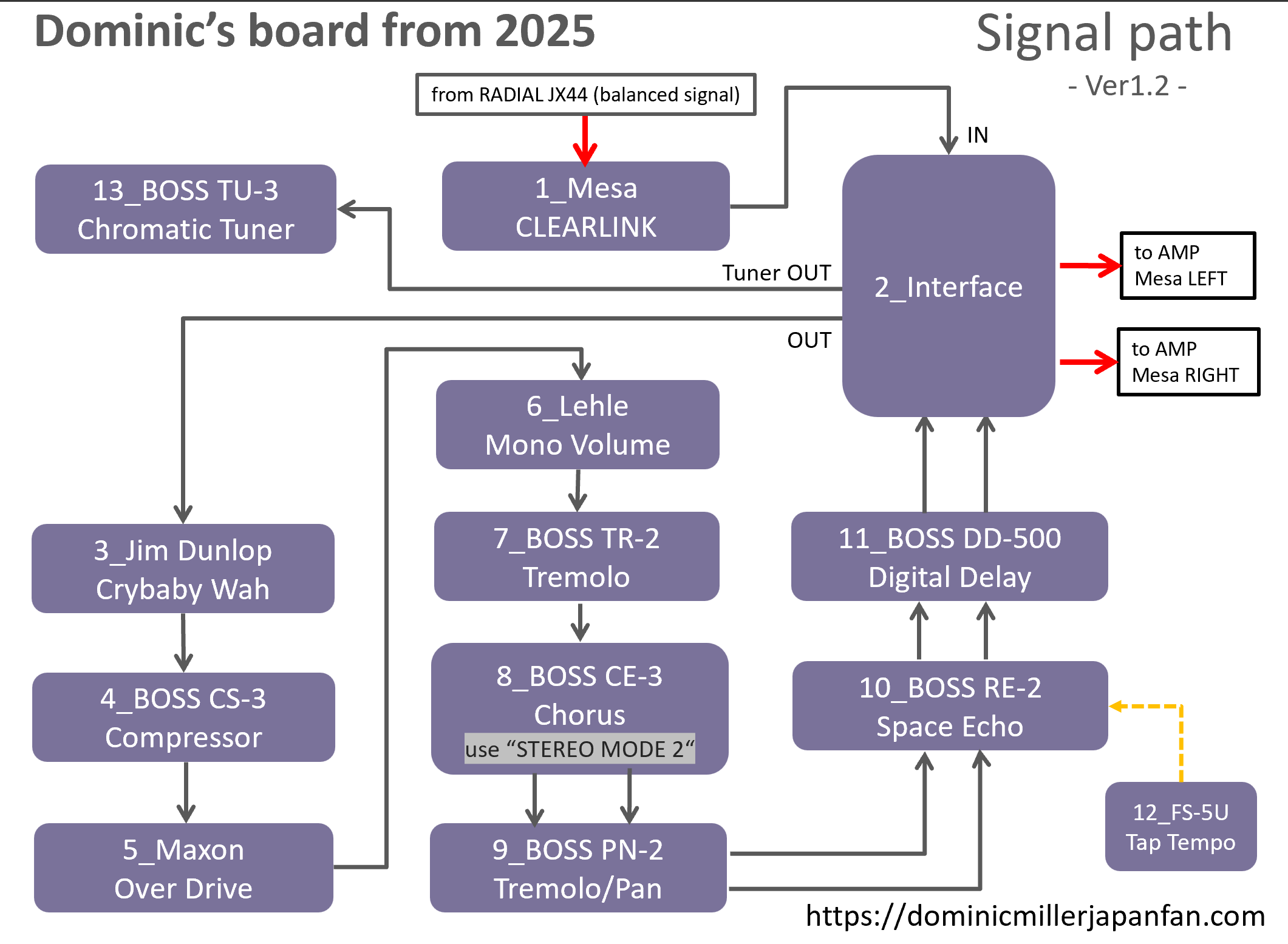
2025.6月6日時点ペダルボード
2025年6月6日更新:5月19日のRed Rocksでのライブの時に少し機材のトラブルがあったようで、リッチーに確認したところ、アーニーボールのボリュームペダルが故障し、Lehleの 「Mono Volume S」に「Mono Volume」に交換されました。配線の順番は下の図の通りです。
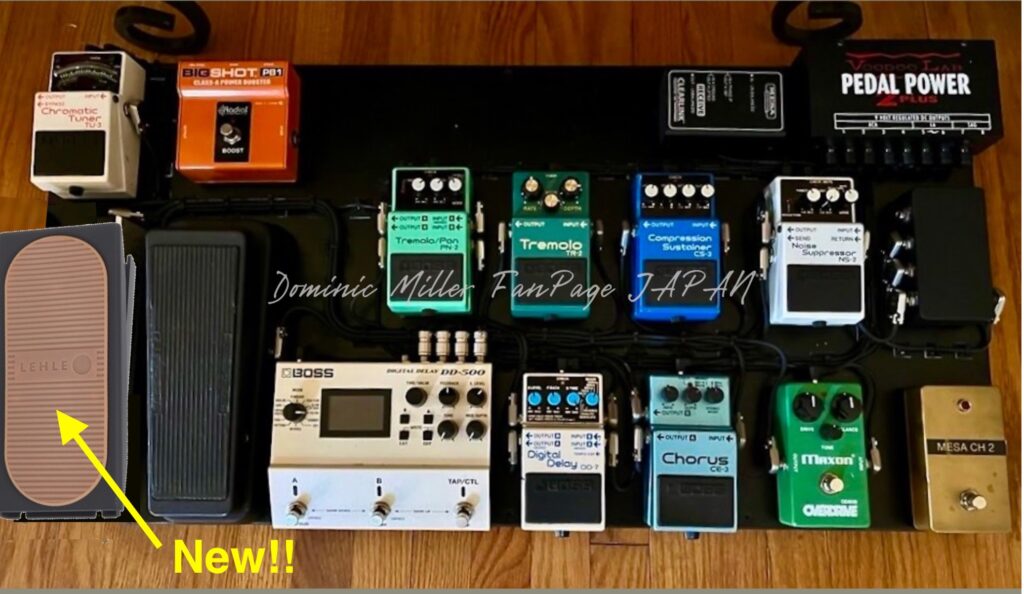
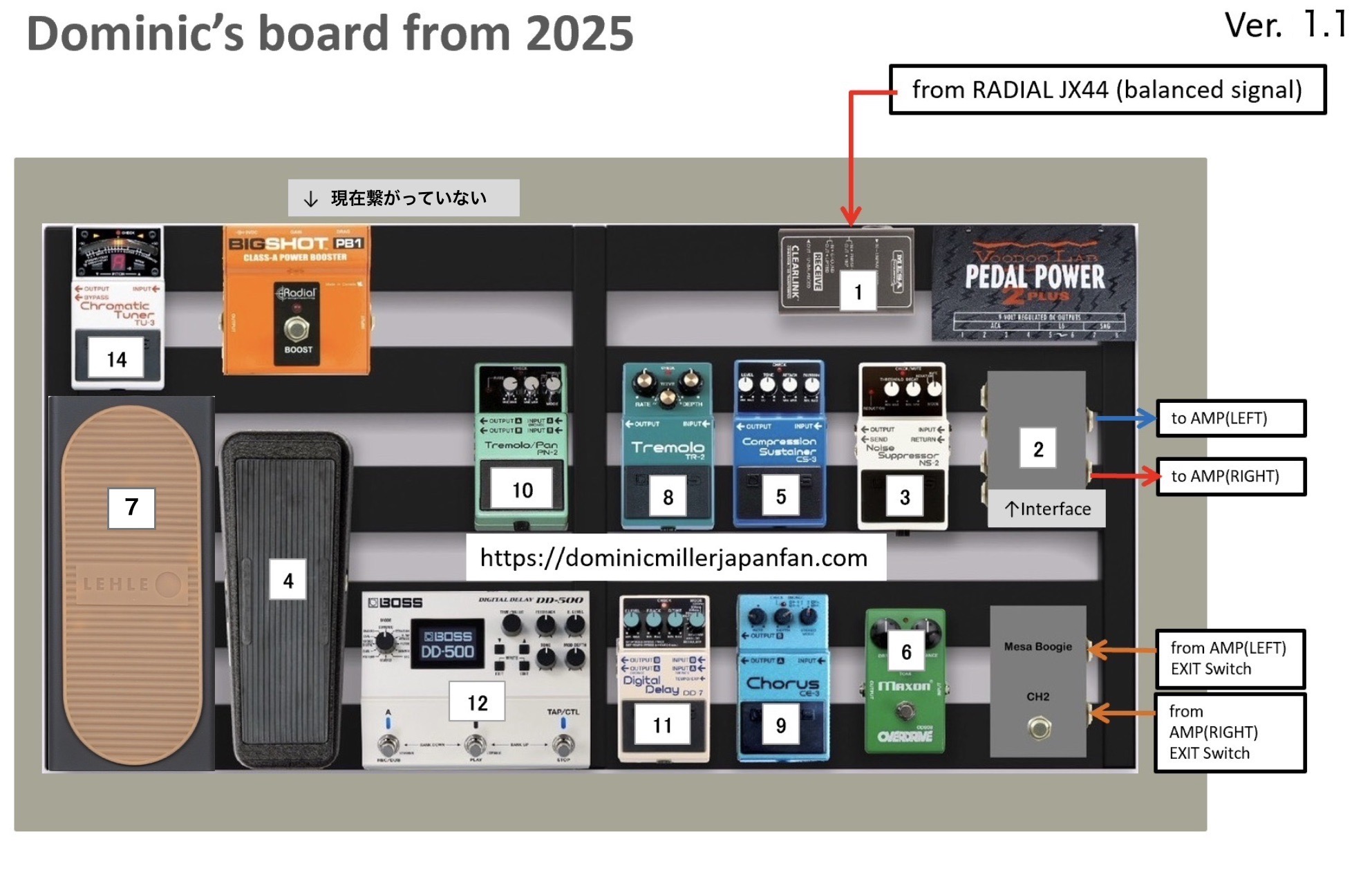
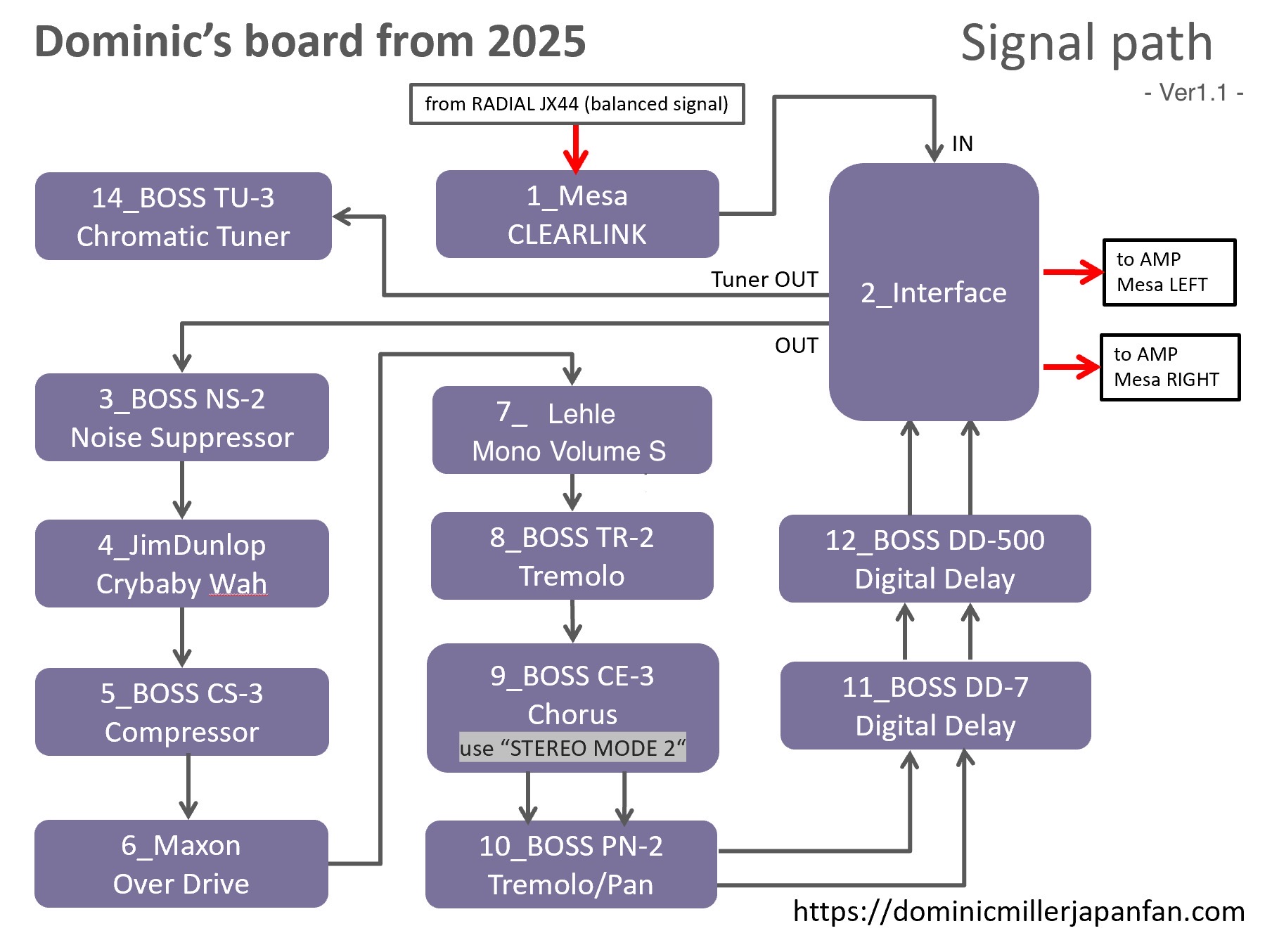
2025.2月14日時点ペダルボード
ドミニクのギターサウンドは、非常にクリーンなトーンです。しかし、それだけだと通常薄っぺらい音になりがちですが、彼のサウンドには厚みと奥行きがあり、その空間的な広がりが魅力だと思います。そのドミニクのサウンドでは、コーラス、コンプレッサー、ディレイが重要です。ディレイをボリュームペダルの後に配置し、細かく調整することで、彼はまるでバイオリンのような、奥行きと広がりのあるサウンドを作り出しています。
ペダルボードはクラシックなプロ仕様のペダルトレインを採用しています。その上に合板のようなものを貼っています。すべては Voodoo Lab Pedal Power 2 によって駆動されます。ご覧のとおり、ドミニクは特殊で変わったペダルやエフェクターを使用していません。すべて一般的に入手可能なものです。つまり、特別にハイエンドなものではありません!
9番のBOSS CE-3 Chorusのステレオ・モード2を使用して、ステレオで音を出力。その後11番のBOSS DD-7 Digital Delay12万のBOSS DD-500 Digital Delayという2つの異なるディレイを曲に応じて微妙に使い分けることでドミニクは音のアクセントや深さを微妙に調整します。
このBOSS DD-7 Digital Delayは基本的に800msに設定されています。2023年の夏頃から最近まで、ここにはBOSS RE-2 Space Echo が ありBOSS FS-5U タップテンポ付きペダルで制御されていましたが、今回変更されました。この時、BOSS RE-2 Space Echo も800msに設定されていました。しかし、ドミニクは以前にもBOSS DD-7 Digital Delayも使用していたことがあり、状況に応じて異なるディレイ・エフェクターを使いわけることが多いようです。
後、右下に金色のMesa Boogie Lone Starアンプのチャンネルモードを切り替えるスイッチがあります。それを使ってLonestarのChannel1とChannel2の切り替えが可能。Channel1はクリーンサウンド、Channel2はクリーンモードとドライブモードを切り替えることが出来、それぞれ細かい設定が可能です。
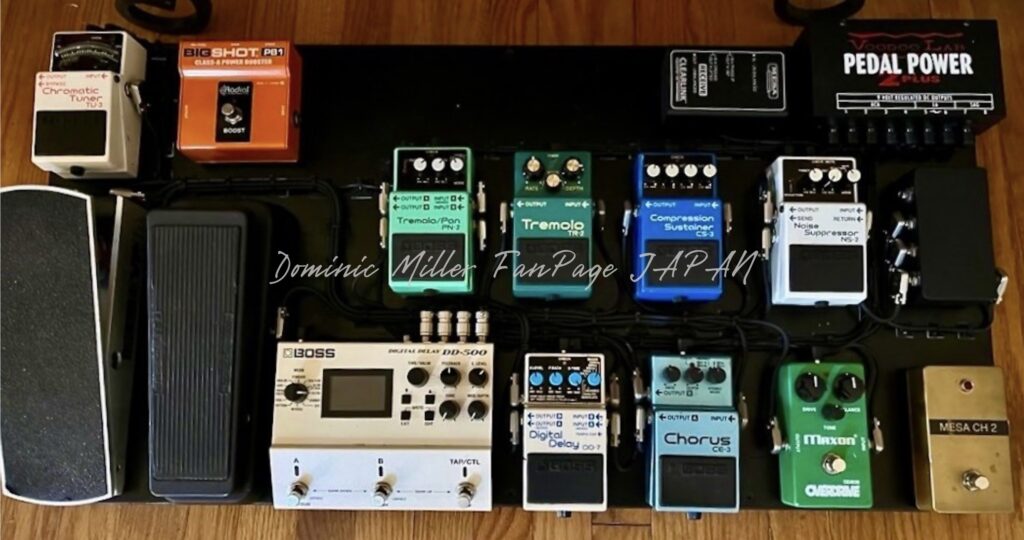

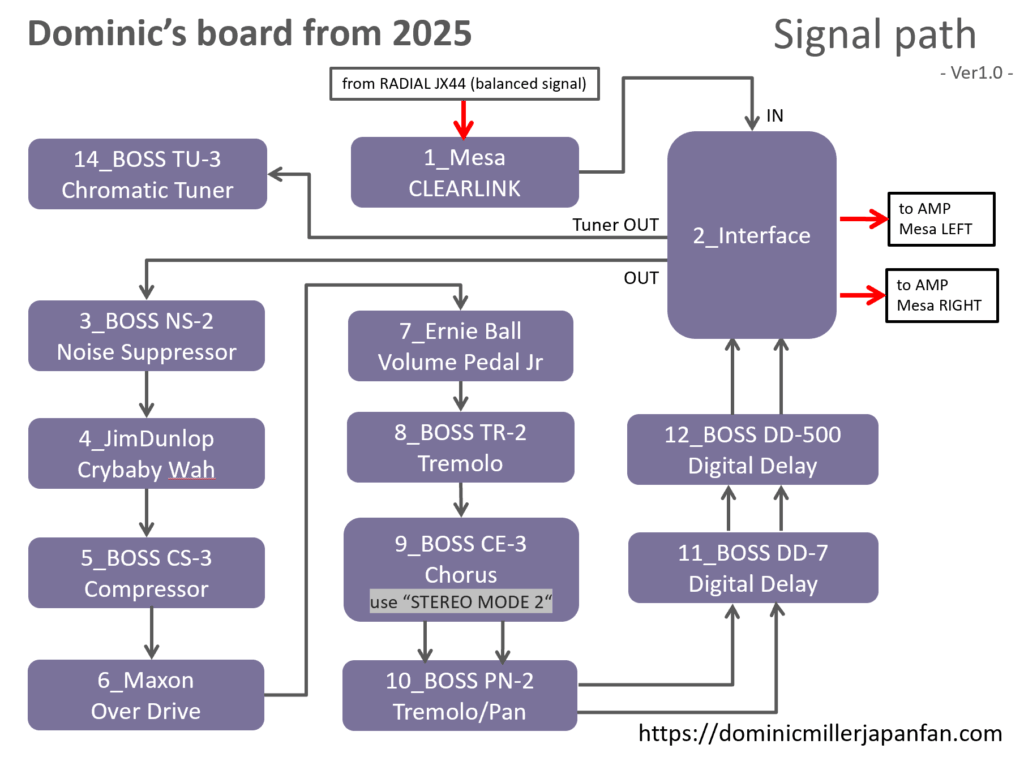
スティング3.0ツアー開始時
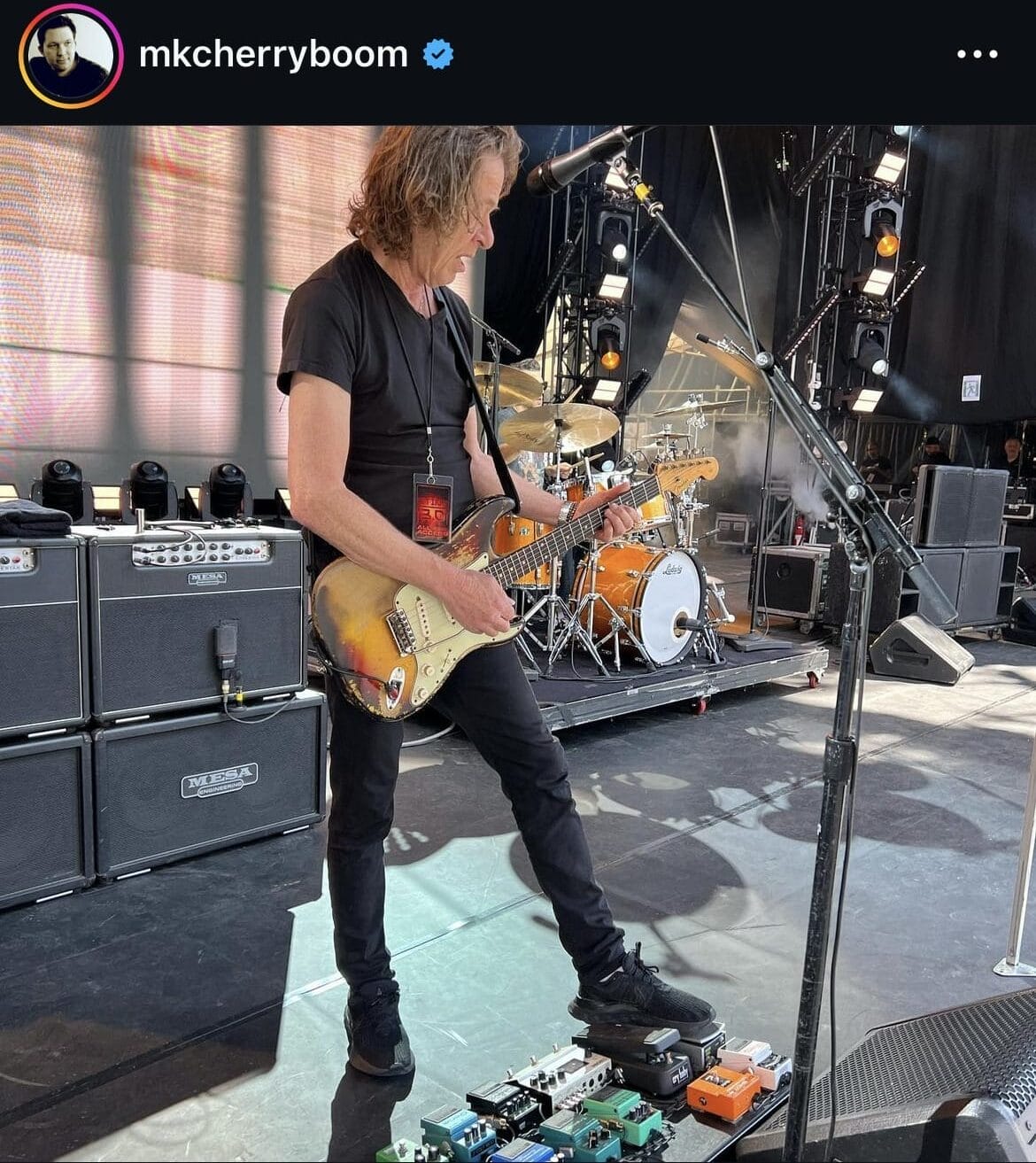
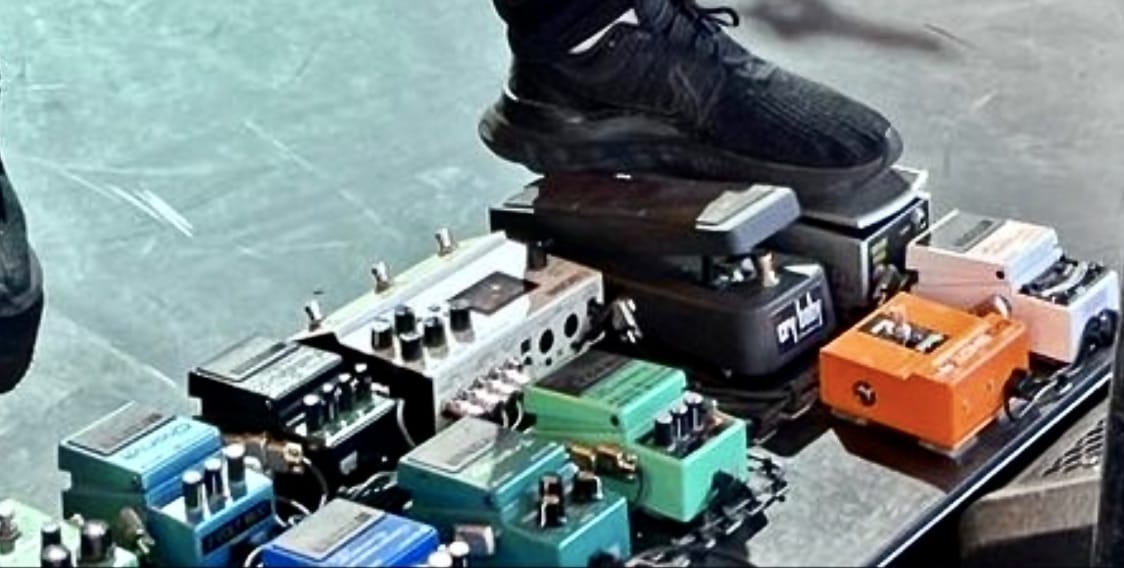

Mesa Boogie Lone Starのセッティング
この写真と今が完全に同じかどうかわからないが、おそらく変更はないはずです。ドミニクはMesa Boogie Lone Starの1×12 Combo + 2×12 Rectifier Horizontal Cabinetのセットを右左に組んで2セット使用しています。
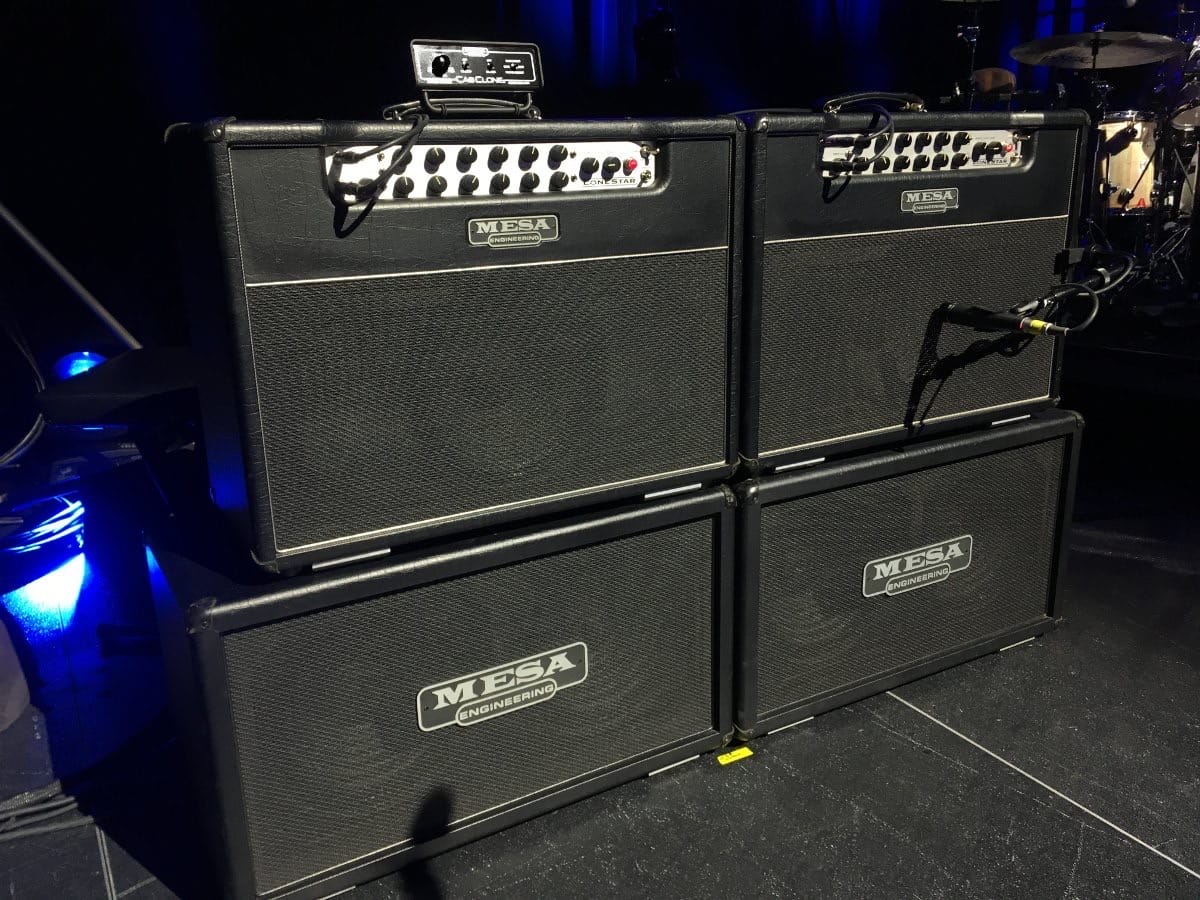
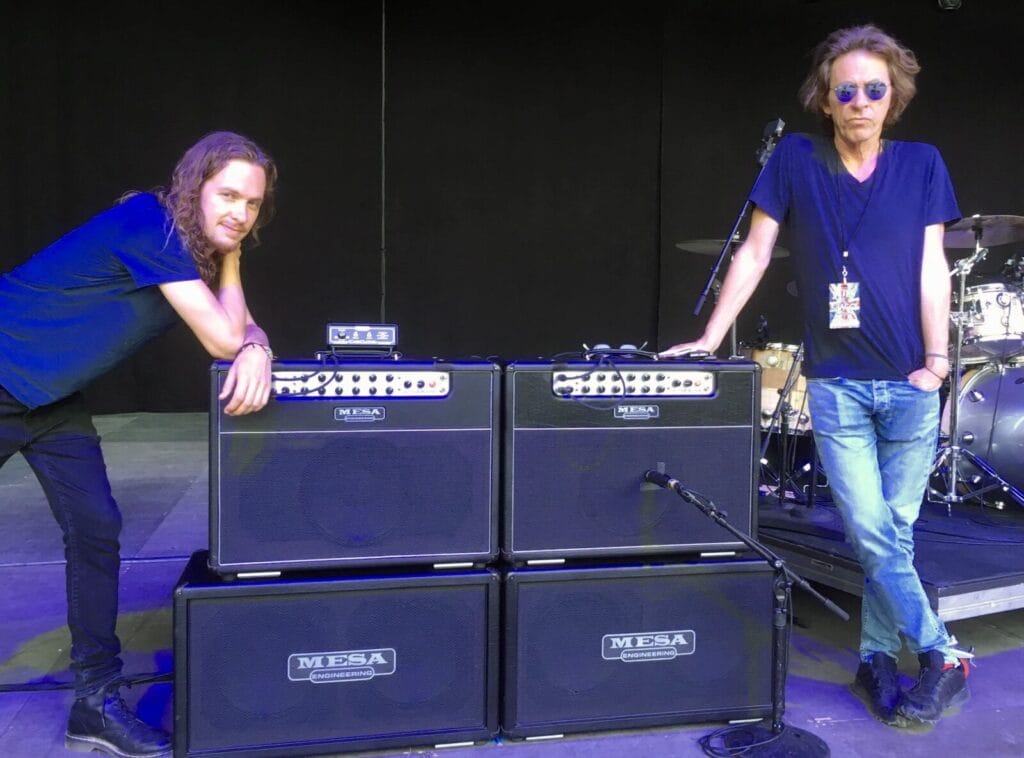
リッチーによると、Channel2は、Channel1よりも少しだけ大きな音量に設定されているそう。そしてドミニクは1回のライブ中はほとんどChannel1を使用し、Channel2を使用するのは数回だそうです。Channel2は基本的にドライブのサウンドに設定してあり、ソロの演奏時などに使ってるんじゃないかと思います。
Mesa Boogie Lone StarでDominicのようなサウンドを得るには、コントロールを以下の位置に設定します。時計で言うと、Gain、Treble、Presenceを10時30分、MidとBassを2時00分に設定します。以下のフロントパネルの図を参照してください。ただ、コンプレッサーとコーラスのエフェクターを繋がないとそこまでドミニクっぽくはならないので最低限その二つをつける必要があるでしょう。また、 Lone Starは背面にリバーブもついていますが、ドミニクは全く使っていません。
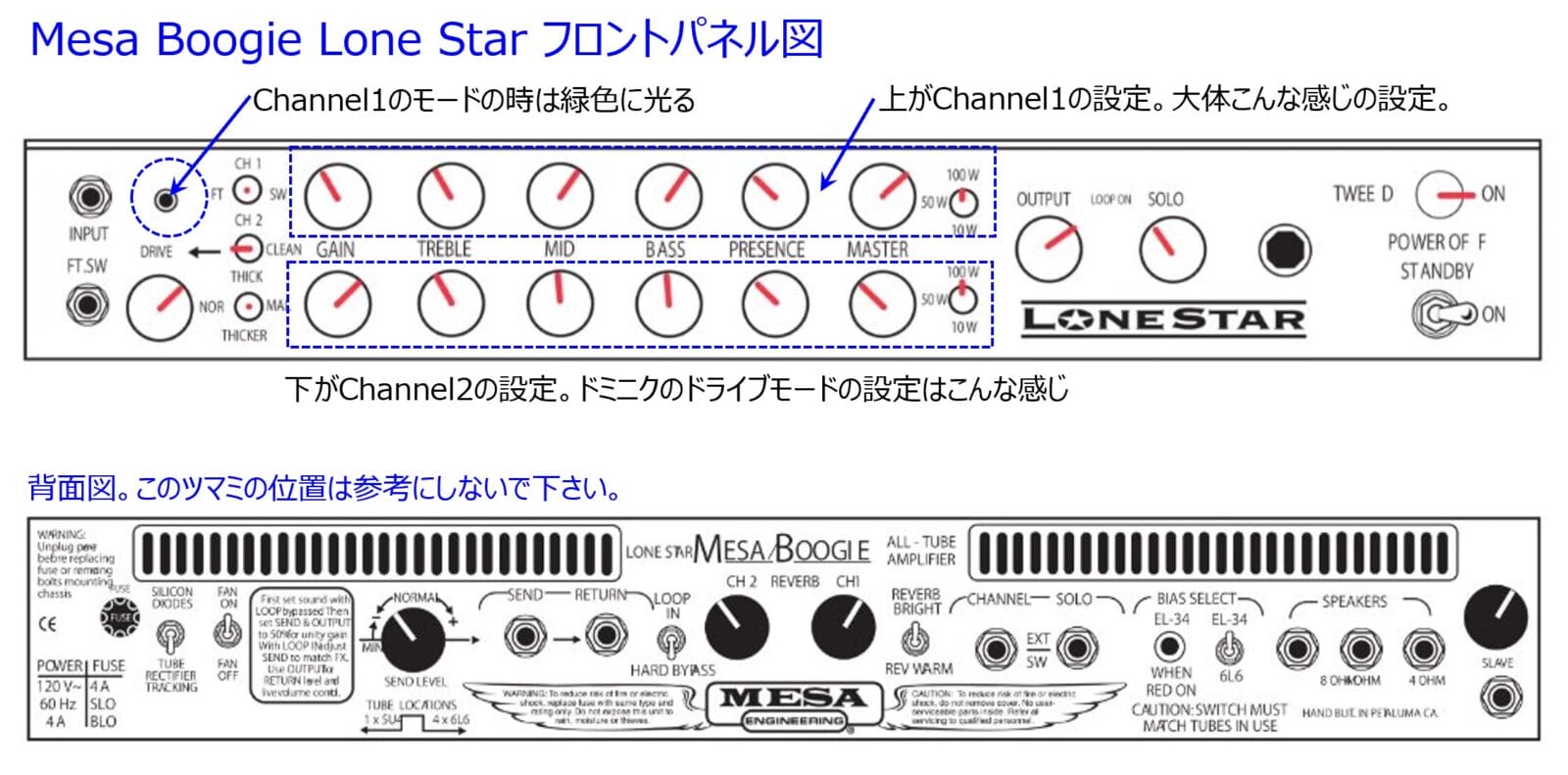
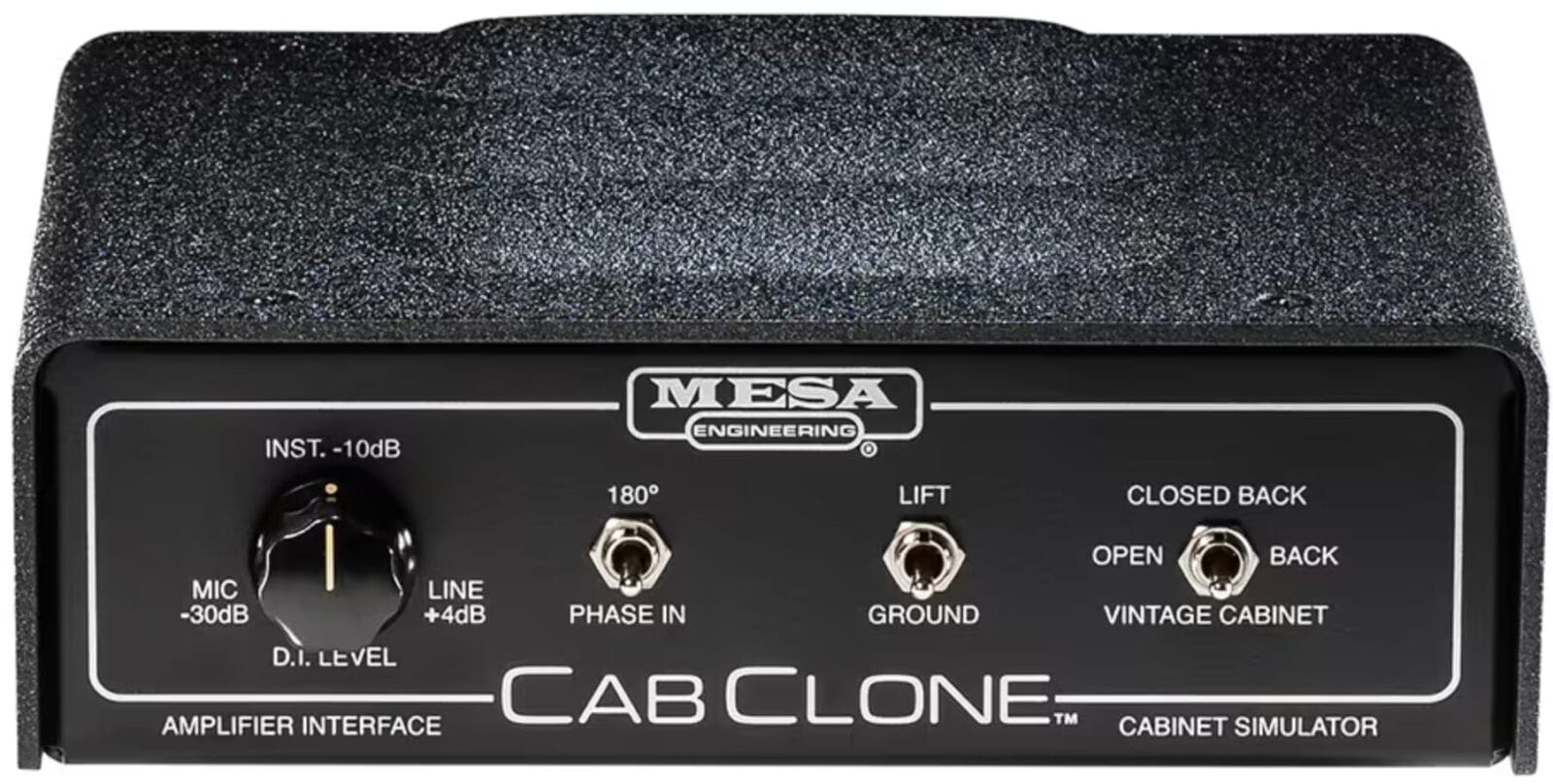
Cab Clone
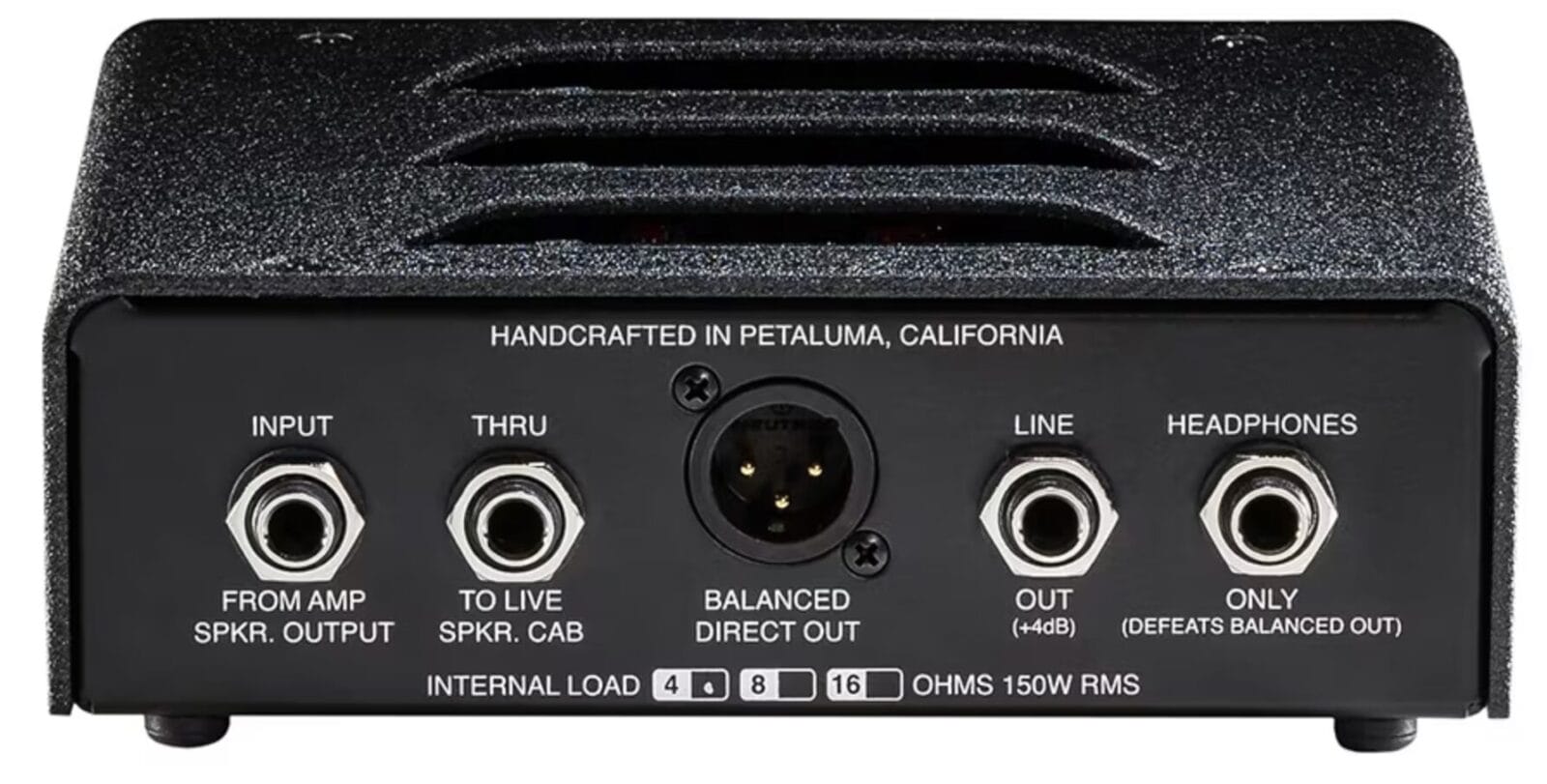
また通常、ドミニクはあまり自分自身ででアンプのボリュームを上げすぎないように心がけているそうだ。それについては下の2016年のインタビューの中にも書かれている。
ーアンプの設定とボリュームに関するドミニクのコメント –
DM:「ステージで大きすぎると、音響担当者が PA で音量を下げて、薄い音になってしまいます。ステージで大きく太い音を出すには、ステージレベルを自分が思っているよりも低く抑え、音響担当者が PA であなたをサポートしてくれることを信頼する必要があります。音量を低く抑えておくのもコツの 1 つです。そうすれば、音響担当者はあなたが何をしているのかを本当に聞きたがるようになります。こうすることで、コントロールできるのは彼ではなく、あなた自身になります。」

ステージ上で
ドミニクの場合、上記に書いたように右のMesa Boogie Lone Starの音はマイクで拾われているので音が出ているわけです。しかし、ドミニクはイヤー・モニターは使わないので、ステージ上ではアンプからとモニターからの2種類の音を聞いている事になる。だから、ギタリストとしてステージに立った事がない私は、この2種類の違う音が聞こえる状態では演奏しにくいのではないかと思い、その疑問をリッチーに聞いてみました。すると、その件についてのリッチーの返答はこうでした。
RM: “実際、私たちが「ゾーン」と呼んでいる場所は、ライブ演奏を行うには最高の場所です。アンプからパワーと素晴らしいトーンが得られ、ドムを囲むように配置されたモニターがそのトーンをサポートします。素晴らしいですね!ステージの両側には大型モニターも設置されており、ドムがステージを歩き回る際に、モニターエンジニアが音量を上げます。本当に素晴らしいです!”
また、彼は「Lone Starはステージ上のモニターよりも音量が大きいです。オーバードライブを使用したいときに、適切な量のフィードバックを生成するのに十分な音量です」と言ってたので、リッチーの言う「ゾーン」では、モニタースピーカーからのギターの音は小さめに出ていて、ほとんとの場合、ドミニクはLone Starからの音をメインに聴いてるんだと思います。
まとめ
私はこのサイトの中で何度も言っていますが、ドミニクは「器材オタク」ではありません。あくまでもいい音を出すのは「自分の腕次第。」という考え方の人です。特にドミニクの場合は、アコースティックギターだけでなく、エレキギターも指で弾く事が多く、「全ては自分の右手の指のニュアンスにかかっている」とハッキリ言っています。ですから、ここで紹介した機材を全てこの通りにしても、あなたの音はあなたの音であって、ドミニクと同じにはならないでしょう。
でも、この記事の内容がドミニクのような良い音を求めている方にとって、何かのガイドになれば幸いです。
また、リッチーの話を聞いて感じたのは、本当にドミニクとステージ制作スタッフの間には強固な信頼関係がある、という事です。ドミニクは、リッチーやPAクルーのチームを本当に信頼している。
日本では、ドミニクの音楽はとても繊細なので、彼をステージやスタジオのマイキングについて細かい注文を付ける少し神経質な人だと思っている人もいます。しかし、彼は自分がステージスタッフに細かい注文を出すようなタイプではないと思います。ドミニクは自分がマイキングやPAなどに細かい注文を付けるよりも、それは彼ら専門技術者を信頼して任せて、自分はあくまでも彼らの期待に応えられる演奏をする事が仕事だと考えていると思います。
最後に、2024年7月頃からこの記事のためにリッチーに数えきれないほどの質問を投げかけましたが、彼はそれらすべてに丁寧に答えてくれました。私は、彼がミュージシャンが信頼できる本当に誠実で信頼できる人だと断言できます。リッチーはじめ、自分の仕事に誠実で真摯なスタッフがいるから、ドミニクは安心してステージで最高のパフォーマンスを発揮できるのだと実感しました。
ドミニクが信頼するギター・テック、リッチー・マゼッタ、そしてスティングのステージスタッフ全てに最大の感謝を送りたいと思います。
また、この記事を書くにあたり、ドミニクの大ファンである3人の日本人ギタリストから多大な協力を頂きました。ギターを弾いたこともない私には、彼らの協力がなければこの記事を書くことはできなかったでしょう。Mr. Yoshimi Taniguchi、Mr. K.Akiyama、Mr. Yousuke Taniguchi、本当にありがとう!
Gallery
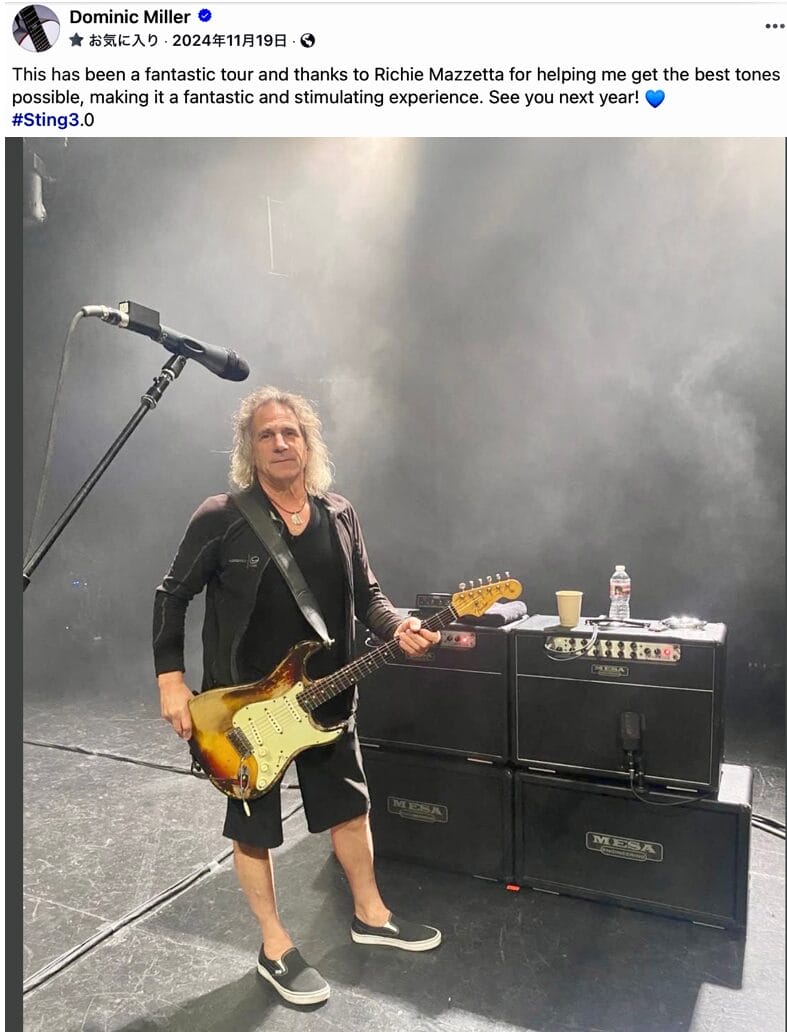
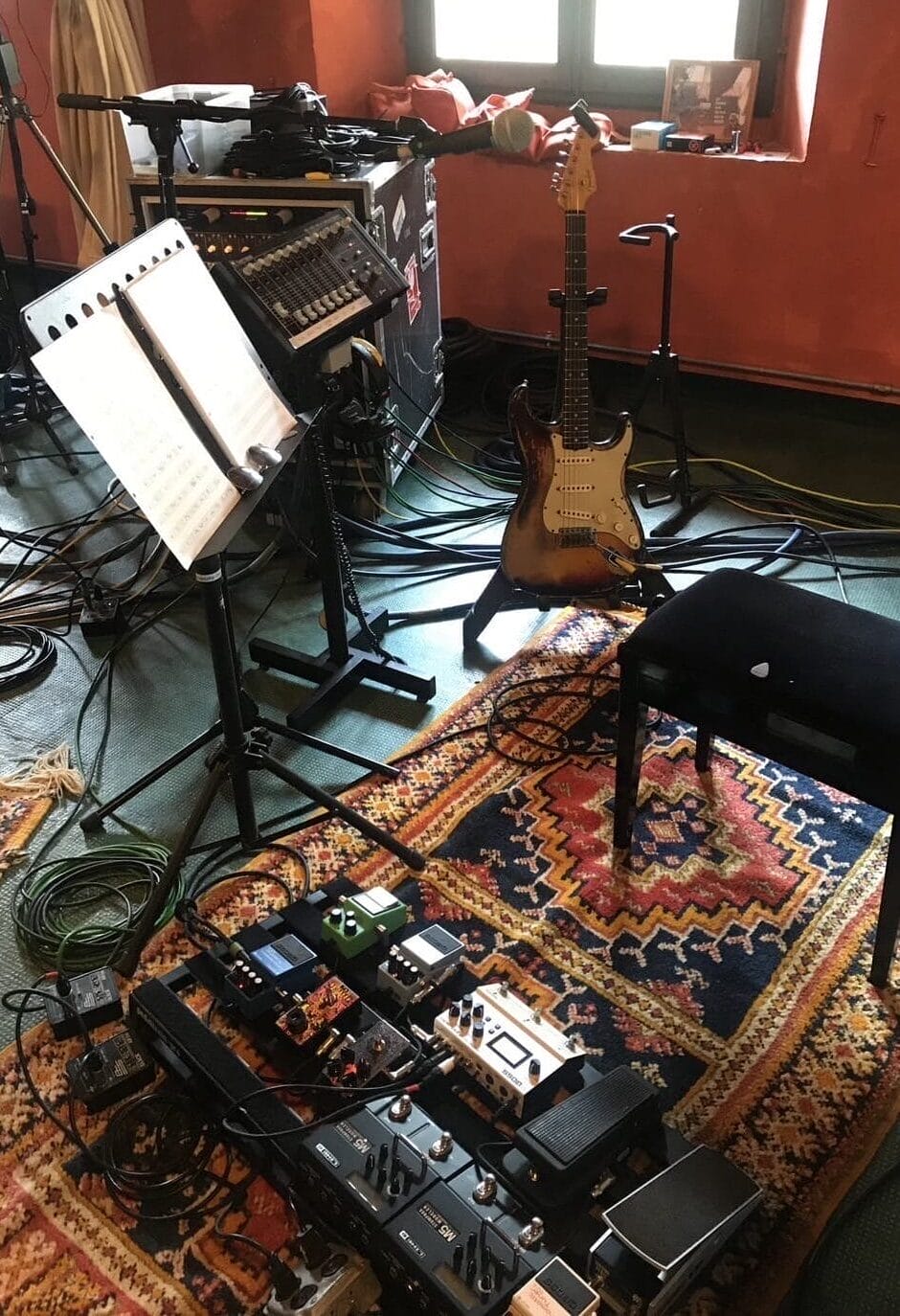
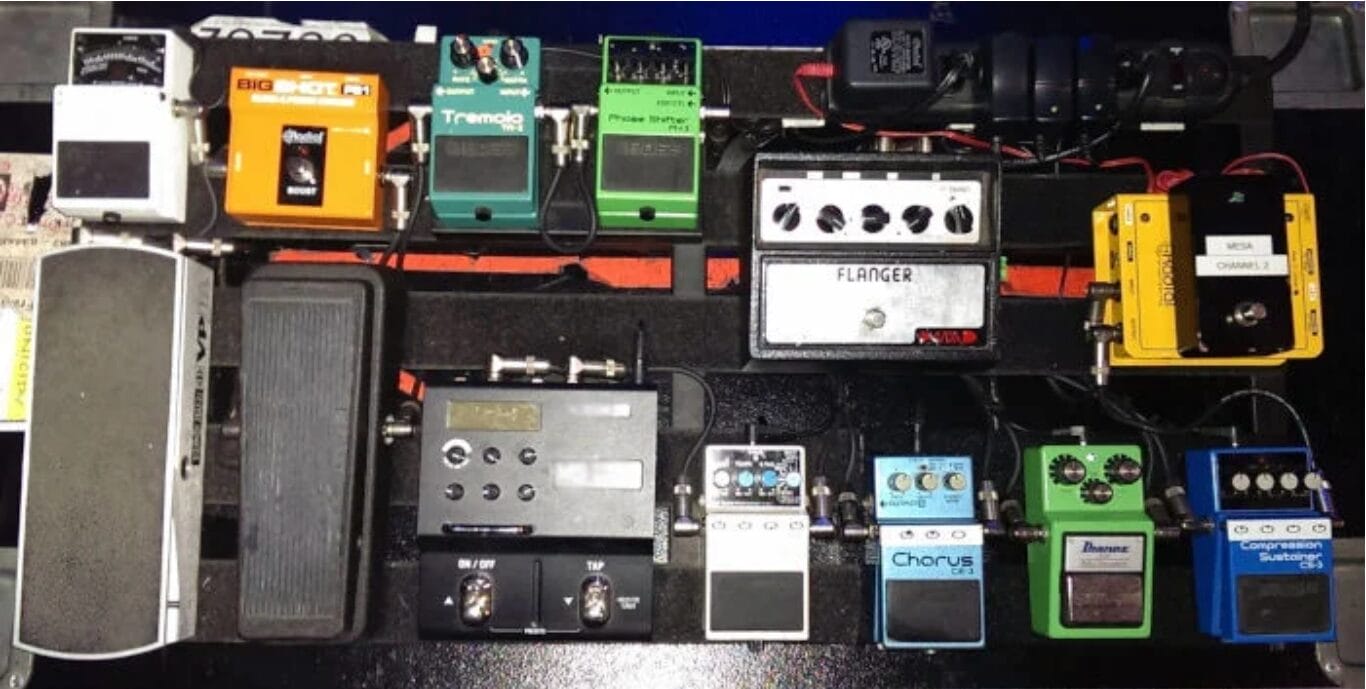
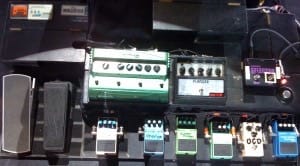
Pete Cornish Rack Effects System for Dominic Miller 1990
